How effective are vaccines. Gimbe Report
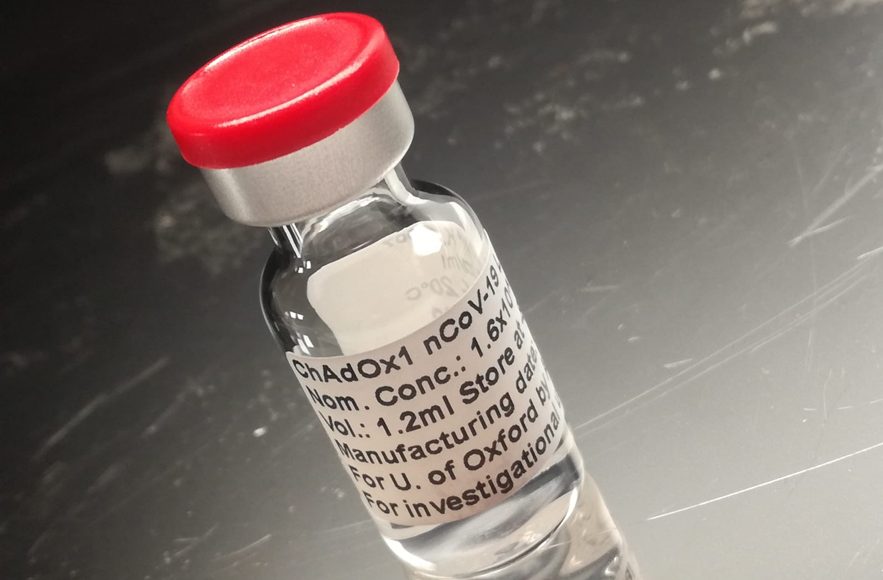
"The effectiveness of the vaccine from April to today is confirmed as stable and very high in reducing deaths (96.3%) and severe forms of the disease that require hospitalization in the medical area (93.4%) and in intensive care ( 95.7%) ". What emerges from the latest report of the Gimbe Foundation
The efficacy of the vaccine from April to today is confirmed as stable and very high in reducing deaths (96.3%) and severe forms of the disease that require hospitalization in the medical area (93.4%) and in intensive care (95 , 7%). With regard to the diagnosis of SARS-CoV-2, on the other hand, the effectiveness decreased from 88.5% (period 4 April-11 July) to 77.3% (period 4 April-5 September), in an inversely proportional measure. at age: in fact, in the 12-39 age group, efficacy has dropped to 67.2% in the past few weeks, and now, after stabilization, it seems to be recovering (Figures 17 and 18).
This is what emerges from the update of the analysis of the Gimbe Foundation on the progress of the vaccination campaign in Italy.
"This confirms – explains Nino Cartabellotta, doctor and president of the Gimbe Foundation – that during the summer period among the youngest must have influenced the increase in social contacts and less attention to individual behaviors, essential to prevent contagion even in vaccinated people ".
Compared to non-vaccinated subjects, there is a sharp decline in the incidence of diagnosis and especially of severe disease leading to hospitalization, hospitalization in intensive care or death: in the various age groups, the diagnosis of SARS- CoV-2 in fact decreased by 77.8-80.7%, ordinary hospitalizations by 88.8-95.6%, those in intensive care by 92.5-97.4% and deaths by 93.4- 100%.
Here is the full text of the Gimbe Foundation weekly report
++++
The independent monitoring of the Gimbe Foundation detects in the week 8-14 September 2021, compared to the previous one, all the declining numbers. New cases drop (33,712 vs 39,511) (figure 1), deaths (389 vs 417) (figure 2), currently positive cases (122,340 vs 133,787), people in home isolation (117,621 vs 128,917), hospitalizations with symptoms (4,165 vs 4,307) and intensive care (554 vs 563) (figure 3). In detail, compared to the previous week, the following changes were recorded:
- Deaths: 389 (-6.7%), of which 52 referred to previous periods
- Intensive care: -9 (-1.6%)
- Hospitalized with symptoms: -142 (-3.3%)
- Home isolation: -11,296 (-8.8%)
- New cases: 33,712 (-14.7%)
- Currently positive cases: -11,447 (-8.6%)
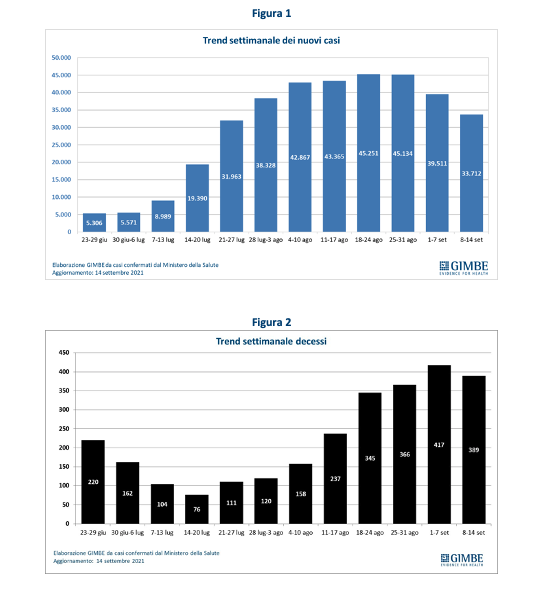
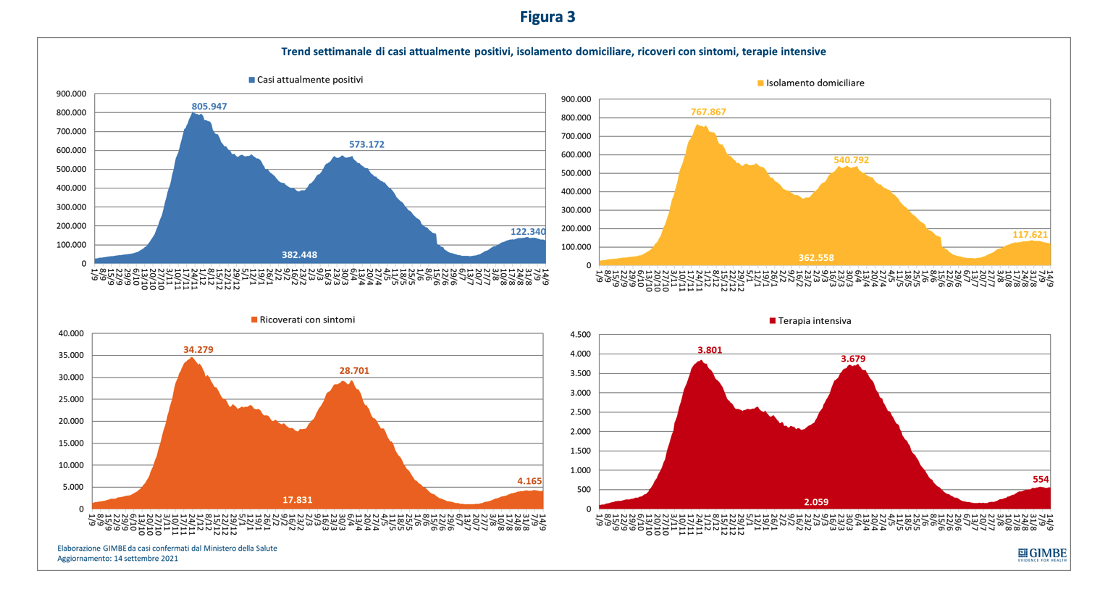
"The new weekly cases continue to decrease – declares Nino Cartabellotta, President of the Gimbe Foundation – both as absolute numbers and as a moving average of daily cases which stands at 4,816" (figure 4). In the week 8-14 September 2021, compared to the previous one, 4 Regions recorded a percentage increase in new cases and in only 2 Regions the currently positive cases grow (table 1). The provinces with an incidence equal to or greater than 50 cases per 100,000 inhabitants drop to 56: in Sicily and Umbria all the provinces reach or exceed this threshold. Only in 2 Provinces there are over 150 cases per 100,000 inhabitants: Syracuse (178) and Messina (168) (table 2). Deaths also decreased: 389 in the last 7 days (of which 52 referred to previous periods), with a daily average of 56 compared to 60 in the previous week.
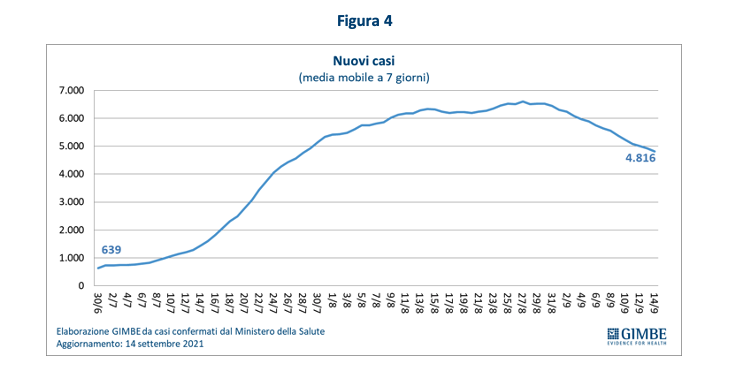
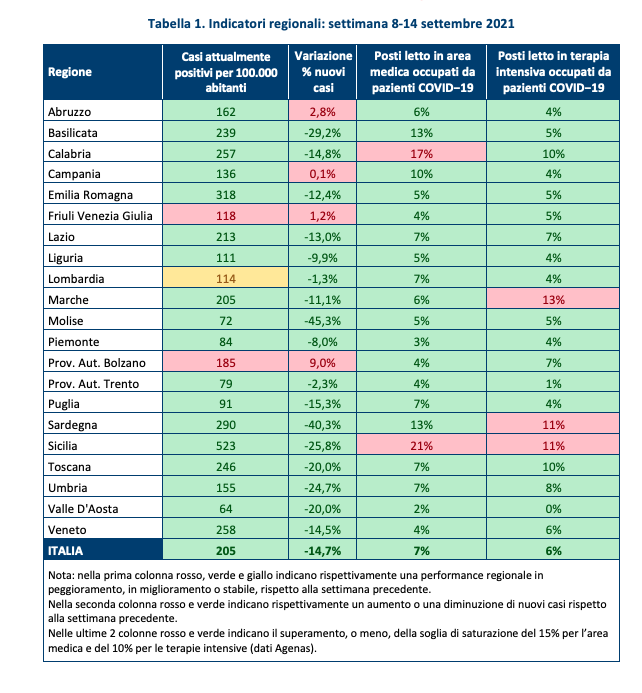
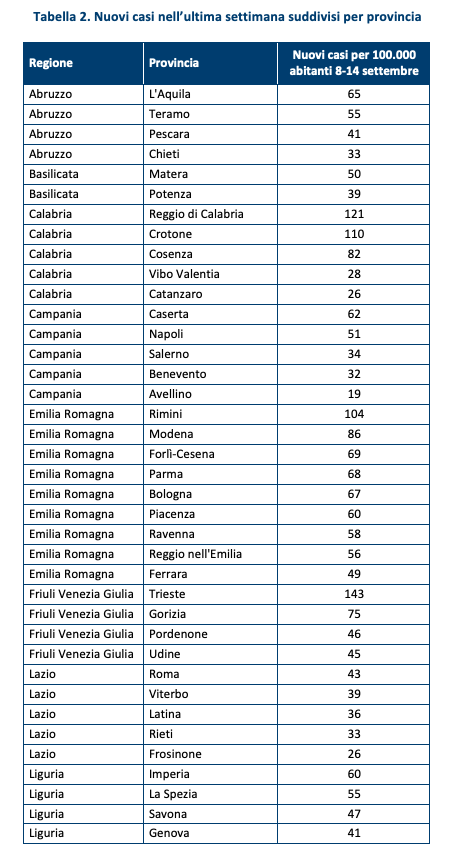
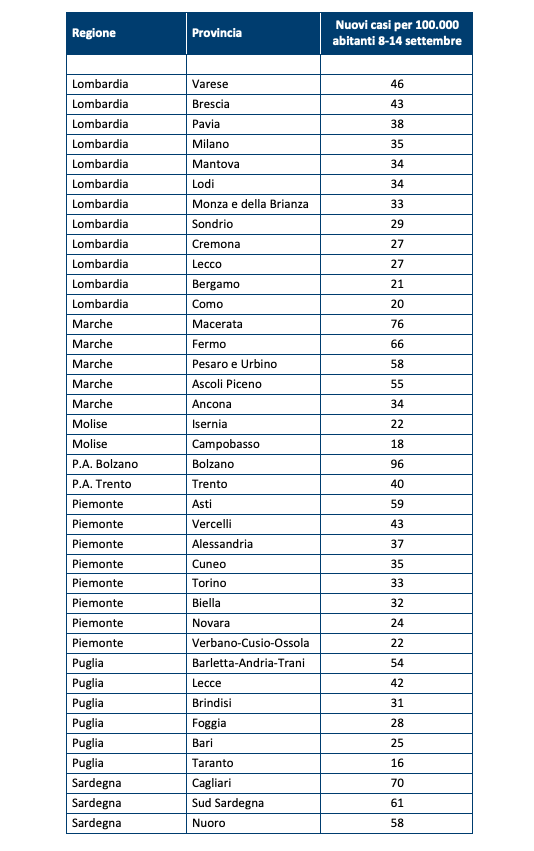
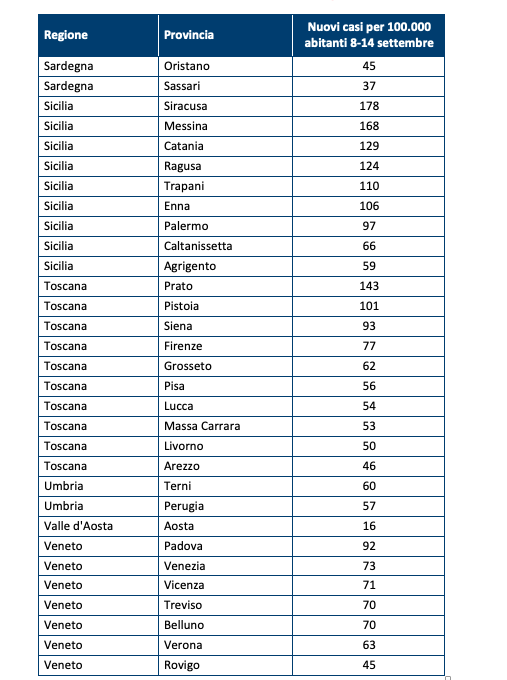
"On the hospital front – says Renata Gili, Head of Research on Health Services of the Gimbe Foundation – after 8 weeks of increase, there is a slight reduction in the number of beds occupied by COVID-19 patients, which decrease by 3.3% in the medical and '1.6% in intensive care ».
At the national level, the employment rate remains low (7% in the medical area and 6% in the critical area), although considerable regional differences persist (figure 5): for the medical area they are above the 15% threshold Sicily (21 %) and Calabria (17%); for the critical area above the threshold of 10% Marche (13%), Sicily (11%) and Sardinia (11%). "Daily admissions to intensive care are also starting to drop – explains Marco Mosti, Operations Director of the Gimbe Foundation – with a 7-day moving average of 36 admissions / day compared to 42 in the previous week" (figure 6).
Vaccines: supplies.
As of September 15 (update at 6.09 am) 91,849,241 doses have been delivered: with 3.7 million doses in the last week (figure 7) the stocks of mRNA vaccines exceed 10 million.
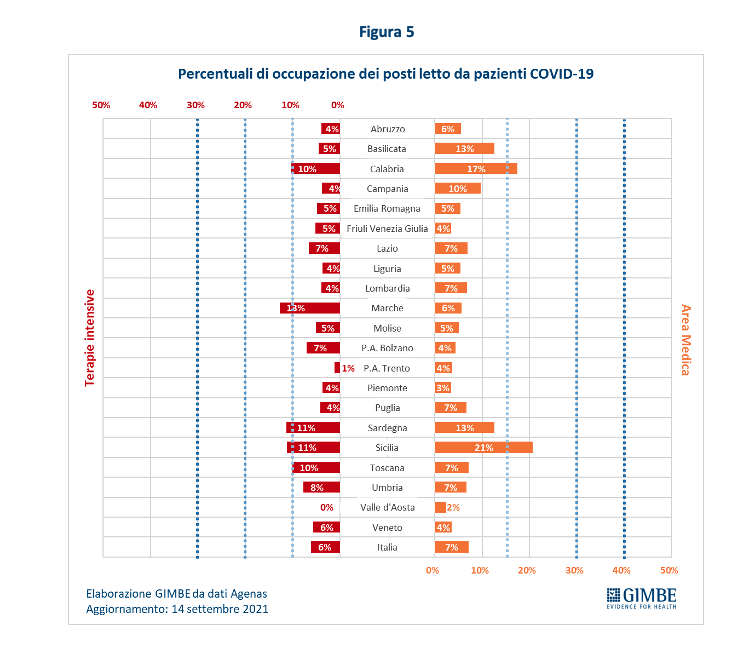
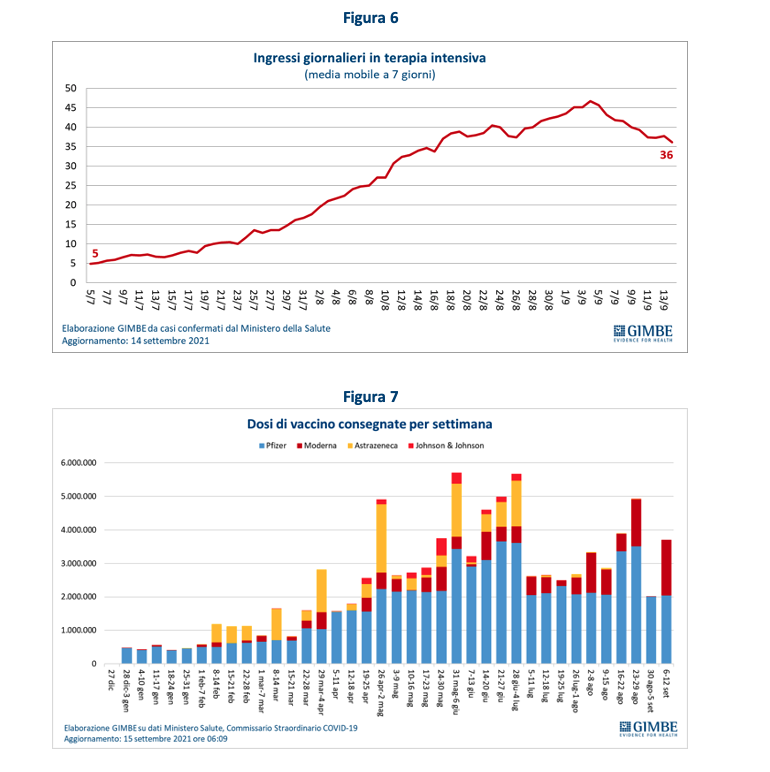
Vaccines: administrations.
As of September 15 (update 06:09), 74.1% of the population (no.43.924.031) received at least one dose of vaccine (+552.102 compared to the previous week) and 68% (no.40.295.980) completed the vaccination cycle (+1.223.873) (figure 8). The number of administrations decreased in the last week (1,720,055) (figure 9), with a 7-day moving average of 234,183 administrations / day (figure 10). «Despite the considerable availability of doses – comments Cartabellotta – the number of first administrations, after three weeks of stability around 720-750 thousand, in the last week has dropped to 525 thousand. While waiting to know the effects of the extension of the obligation of the green pass, it is evident that the current strategies of the campaign are not able to counter the hesitation of the still unvaccinated population ».
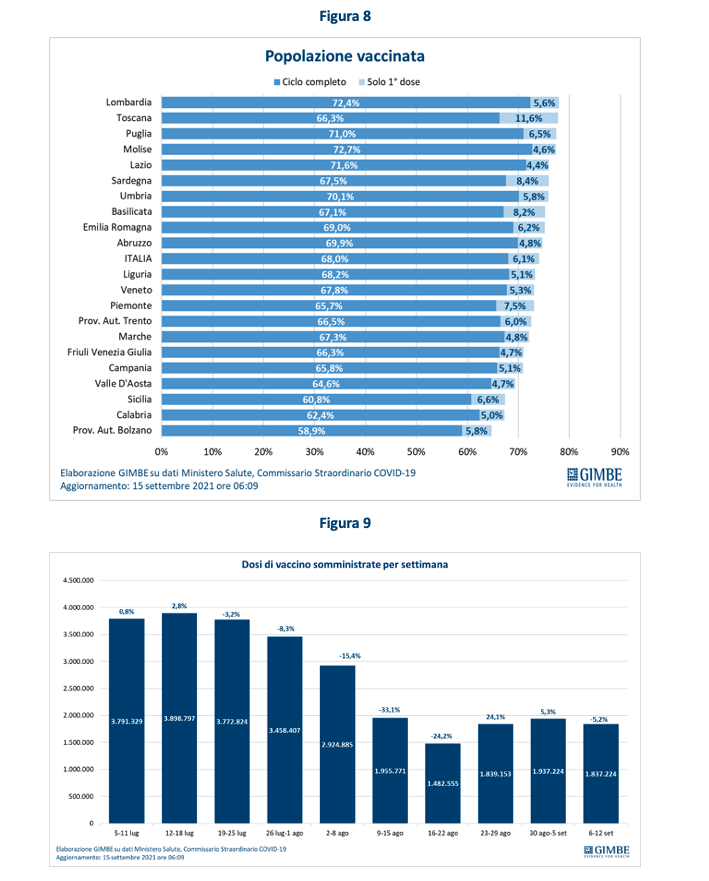
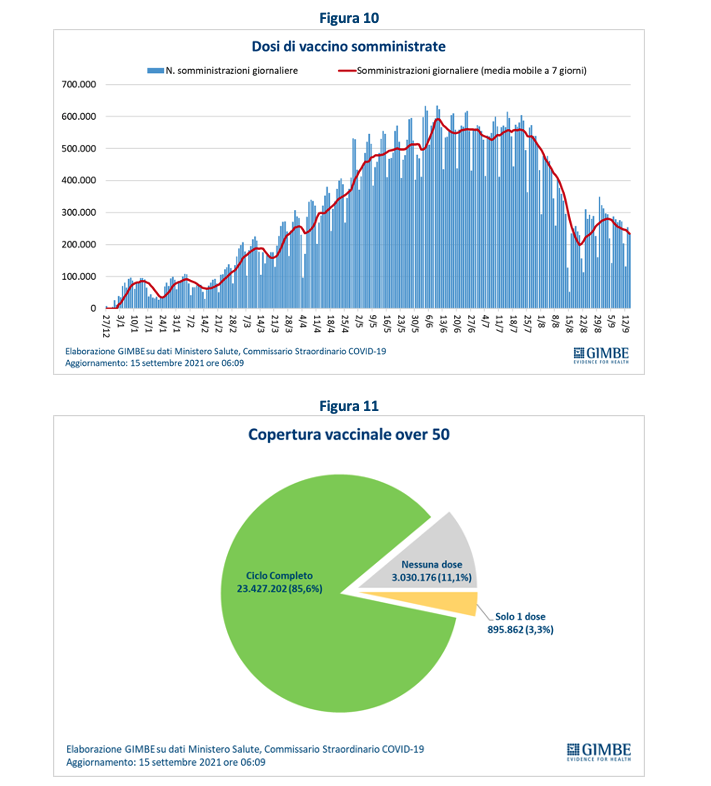
Vaccines: coverage of over 50s.
88.9% of the over 50 population received at least the first dose of vaccine, (+ 0.5% compared to the previous week) with clear regional differences: from 93.3% in Puglia to 83% in Calabria. In detail:
- Over 80: of the over 4.4 million, 4,205,980 (93.9%) completed the vaccination course and 102,620 (2.3%) received the first dose only.
- Age range 70-79: of the over 5.9 million, 5,353,137 (89.7%) completed the vaccination course and 133,144 (2.2%) received the first dose only.
- Age range 60-69: of the over 7.3 million, 6,376,274 (85.7%) completed the vaccination course and 219,502 (2.9%) received the first dose only.
- Age range 50-59: of the over 9.4 million, 7,491,811 (79.1%) completed the vaccination course and 440,596 (4.7%) received the first dose only.
Overall 3.9 million over 50s (14.4%) have not yet completed the vaccination cycle (figure 11), with significant regional differences (from 17% in Calabria to 6.7% in Puglia) (figure 12): these, 3.03 million have not yet received even a dose. Faced with a substantial flattening of vaccination trends in this age group, the under-50 curves continue to rise, in particular in the 12-19 and 20-29 age groups who have passed the 30-39 and 40-49 age groups (figure 13). Figure 14 illustrates vaccination coverage by age group while Figure 15 reports, again by age group, the number of people who have not received even one dose. In particular, with schools already broken down, he is concerned that in the 12-19 age group, despite the constant increase in coverage, still 1.53 million children (33.7%) have not received even a dose of vaccine, with significant differences regional (figure 16).
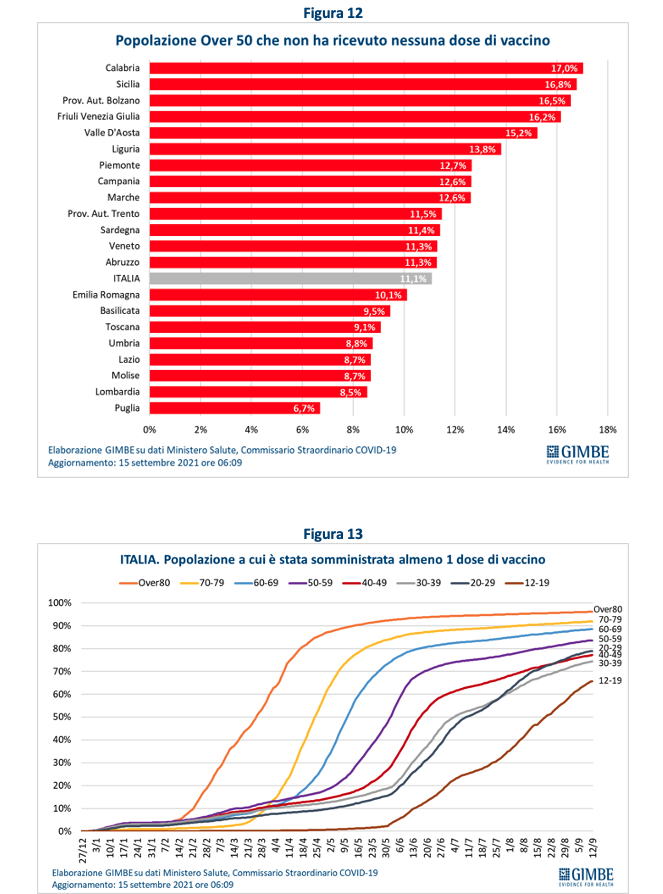
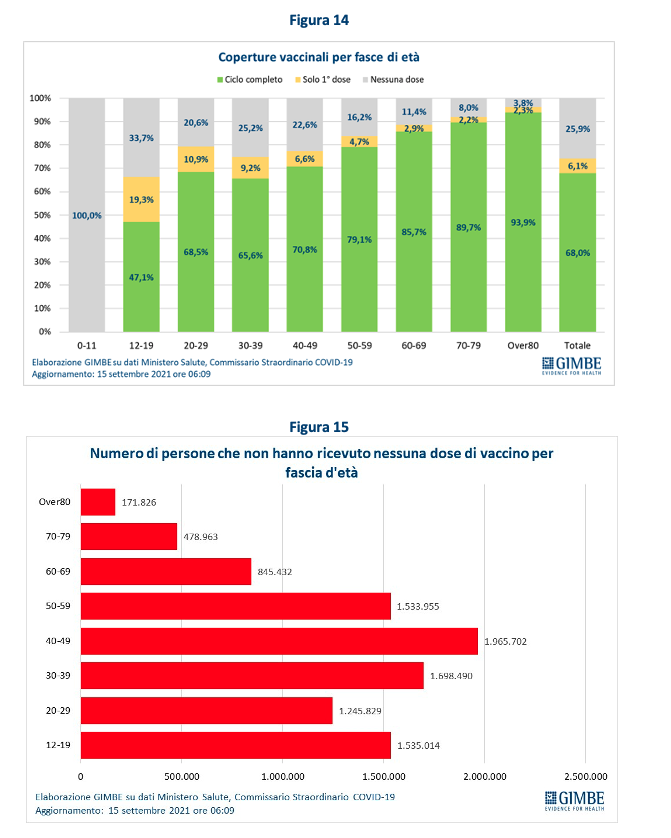
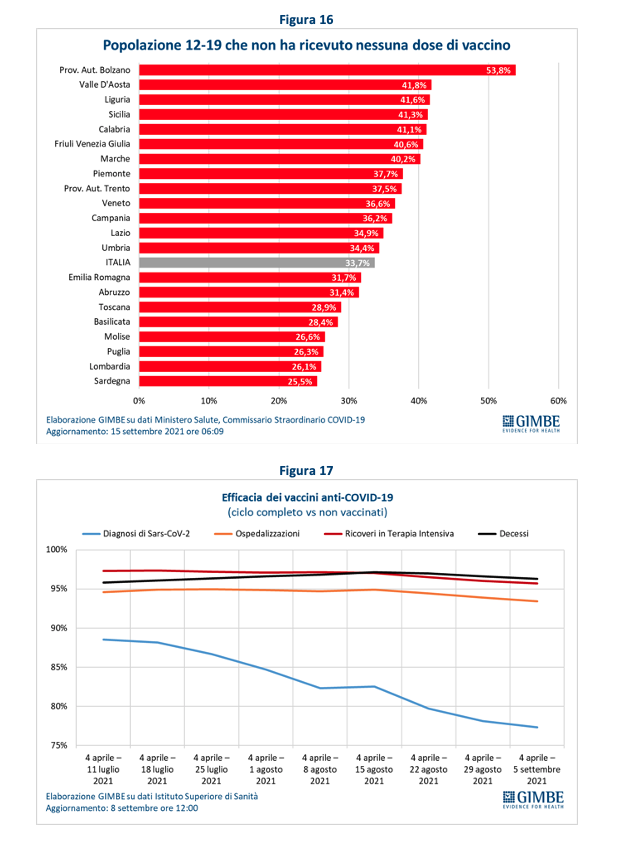
Vaccine efficacy.
The efficacy of the vaccine from April to today is confirmed as stable and very high in reducing deaths (96.3%) and severe forms of the disease that require hospitalization in the medical area (93.4%) and in intensive care (95 , 7%). With regard to the diagnosis of SARS-CoV-2, on the other hand, the effectiveness decreased from 88.5% (period 4 April-11 July) to 77.3% (period 4 April-5 September), in an inversely proportional measure. at age: in fact, in the 12-39 age group, efficacy has dropped to 67.2% in the past few weeks, and now, after stabilization, it seems to be recovering (Figures 17 and 18). "This confirms – explains Cartabellotta – that during the summer period among the youngest must have influenced the increase in social contacts and less attention to individual behaviors, fundamental to prevent contagion even in vaccinated people". Compared to non-vaccinated subjects, there is a sharp decline in the incidence of diagnosis and especially of severe disease leading to hospitalization, hospitalization in intensive care or death: in the various age groups, the diagnosis of SARS- CoV-2 in fact decreased by 77.8-80.7%, ordinary hospitalizations by 88.8-95.6%, those in intensive care by 92.5-97.4% and deaths by 93.4- 100% (figure 19).
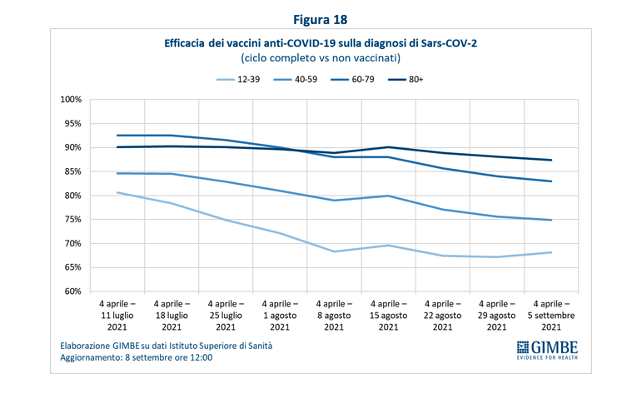
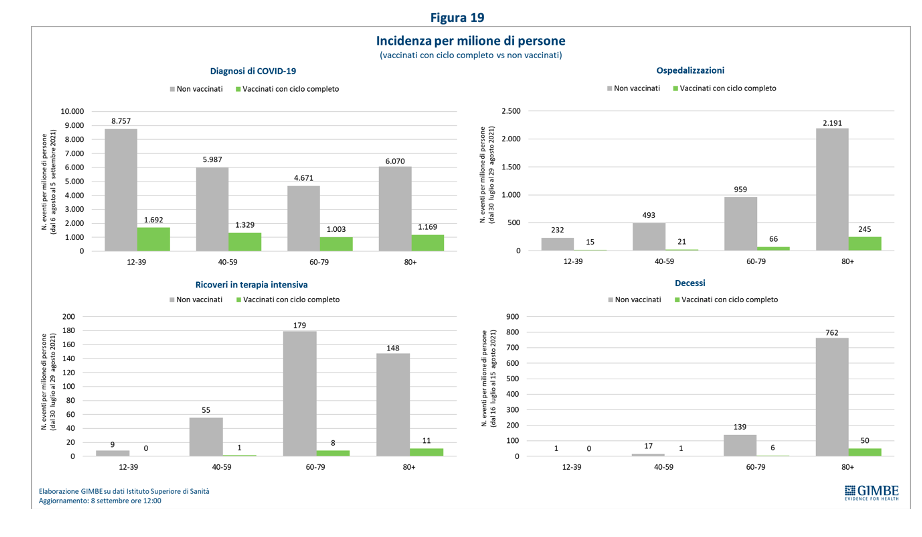
«The progressive increase in vaccination coverage and the adherence to individual behaviors – concludes Cartabellotta – have made it possible to contain the fourth wave and the new cases and hospitalizations have finally begun to decline. However, with the autumn approaching, the reopening of schools and the 9.4 million people, in addition to the under 12, who have not yet received even a dose of the vaccine, there is a risk of a resumption of the circulation of the virus and an increase in hospitalizations with consequent limitations in the care of non-Covid-19 patients. In this context, it is unacceptable to take the position of public figures, including doctors and politicians, who, by subverting the methodology of scientific research, feed disinformation putting people's health at risk. Above all, those who are undecided, who refuse effective and safe vaccines, trusting in unauthorized home therapy protocols or even in harmful and contraindicated drugs ».
This is a machine translation from Italian language of a post published on Start Magazine at the URL https://www.startmag.it/sanita/quanto-sono-efficaci-i-vaccini-report-gimbe/ on Sat, 18 Sep 2021 06:02:28 +0000.
